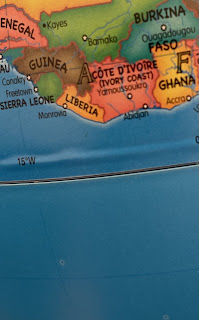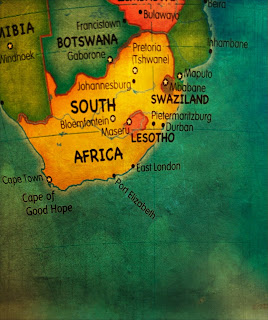READ
The Slave Yards, written by Najwa Bin Shatwan and translated by Nancy Roberts, tells the story of two women. Atiga is a happily married doctor’s assistant, the daughter of a slave and a slavemaster. Tawida is her long-dead mother. The book opens with a visit to Atiga from a man named Ali, who says he is her cousin, the nephew of her father. He has always known of her father’s love for her mother, and he has come to give Atiga her birth certificate, in which her father Muhammad claims paternity. Ali, who appears to have a terminal illness, is also working to obtain Atiga’s rightful inheritance for her.
The first part of the book recounts Atiga’s childhood growing up in the Slave Yards, an encampment near the city of Benghazi. Slaves in Libya had been brought by caravan “from the Niger River basin, the Sudan, Chad, Mali, and wherever they found black people who were hungry and destitute, victims of tribal wars and sultans’ insatiable greed.” Atiga lives with her Aunt Sabriya and Miftah, a white boy whose origin is unknown to everyone except Aunt Sabriya. By virtue of her parentage, Atiga is lighter-skinned than most of the people in the Yards, but it doesn’t seem to matter to the other inhabitants. She works alongside other children her age shifting sand at the seashore for construction workers.
This section of the book is full of stories about life in the
Slave Yards – the work people do to survive, the friendships that grow among
the inhabitants, and the customs and rituals that are observed, such as the
locking ceremony that is performed on girls to ensure that they won’t have sex
until they’re married. It is said that “[t]he motto you had to live by in the
Yards was: only trust in the bad things, since they’re the ones most likely to
come true.”
Atiga is befriended by a young man named Yousef, who keeps an eye on her during her years in the Slave Yards. When tragedy strikes and Aunt Sabriya dies, Yousef takes Atiga to the Josephite Mission Center, where she is cared for and given an education. Later, she and Yousef marry.
The second part of the book tells the story of Atiga’s mother Tawida, who is a slave in the home of a wealthy merchant family. She catches the attention of Muhammad, the son of the slave owner, and he becomes obsessed with her to the point that he won’t even have sex with his wife anymore. While Muhammad’s family doesn’t care that he’s having sex with a slave, they are very concerned that he has developed such deep feelings for Tawida that he is neglecting his duty to his wife and daughters.
The growing consternation of Muhammad’s parents makes life much harder for Tawida, as they find ways to ensure that she aborts or miscarries every time she becomes pregnant. They try to marry her off to another slave and they try to sell her. They send Muhammad away on family business for longer and longer periods of time, but they are unable to end the relationship between the two.
At the end of the book, Ali talks to Atiga about how Italy colonized Libya early in the twentieth century, putting new laws into effect that basically ended Libya’s system of slavery. Atiga tells him: “I’m slavery’s final way station, where slave caravans stopped to rest for the last time, where ‘white’ and ‘black’ blood circulate and mingle in my veins. I was formed out of everything: out of slavery and freedom, water and salt, degradation and dignity, humiliation and honor, sun and soil, hunger and satiety.”
The Slave Yards
was interesting and
informative, with characters that will stay with me for a while. But the
descriptions of the brutality endured by Tawida and other slaves made the book
very hard to read at times. This book is a stark reminder that the purpose of
literature isn’t only to entertain, but to occasionally take us outside of our
comfort zone and force us to confront the harsh realities of life faced by
other people in other places.
COOK
There were several dishes mentioned in The Slave Yards
that were vegan or could have easily been made vegan, but none of them
particularly appealed to me. So I searched the Internet and found a recipe for
Libyan imbakbaka on the Fig
& Olive Platter website. Imbakbaka is basically the Libyan version of
minestrone soup, influenced by the Italian colonization of Libya between 1910
and 1947. Like Italian minestrone, this tomato-based soup is full of vegetables
and pasta. However, the seasonings are different, with the recipe for imbakbaka
calling for cinnamon, turmeric, chili powder, and paprika. It was actually
quite good, and perfect for the cooler fall temperatures we’re experiencing in
Northern California.
GIVE
There were two projects listed for Libya on the GlobalGiving website, and I decided to donate to both of them.
The first project will seek justice for migrants passing through Libya who “are routinely subjected to widespread human rights violations including torture, forced labour and sexual violence.” That’s right – slavery has returned to Libya. According to one news account, there are even slave markets periodically in Tripoli. The justice system in Libya is currently broken, making it difficult to hold the perpetrators of these human rights violations accountable. The group Lawyers for Justice in Libya hopes to “document the cases of migrants that have experienced violations in Libya, work to obtain justice using international human rights mechanisms such as the African Commission on Human and Peoples’ Rights and the International Criminal Court, and facilitate psychological and medical rehabilitation for the victims.” More information about this project is available at Routes to Justice for Migrants in Libya - GlobalGiving.
The second project helps “develop and support young women,
girls and youth in Libya by using sport as an active learning tool around
issues of social cohesion, health and reconciliation.” These are self-awareness
and assertiveness; communication and negotiation skills; confidence;
appreciation of difference and respect; commitment to balancing personal
liberties with social responsibility to others; and a sense of belonging to a
group or polity.” More information about this project is available at Sports for All -
GlobalGiving.
NEXT STOP: LIECHTENSTEIN




















